Nazi book burnings
The Nazi book burnings were a campaign conducted by the German Student Union (the "DSt") to ceremonially burn books in Nazi Germany and Austria in the 1930s. The books targeted for burning were those viewed as being subversive or as representing ideologies opposed to Nazism. These included books written by Jewish, pacifist, religious, liberal, anarchist, socialist, communist, and sexologist authors among others.[1] The first books burned were those of Karl Marx and Karl Kautsky.[2]
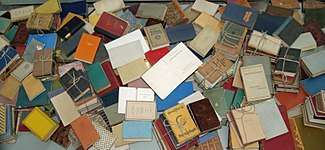
Campaign
On April 8, 1933, the Main Office for Press and Propaganda of the German Student Union proclaimed a nationwide "Action against the Un-German Spirit", which was to climax in a literary purge or "cleansing" ("Säuberung") by fire. According to historian Karl Dietrich Bracher:
[T]he exclusion of "Left", democratic, and Jewish literature took precedence over everything else. The black-lists ... ranged from Bebel, Bernstein, Preuss, and Rathenau through Einstein, Freud, Brecht, Brod, Döblin, Kaiser, the Mann brothers, Zweig, Plievier, Ossietzky, Remarque, Schnitzler, and Tucholsky, to Barlach, Bergengruen, Broch, Hoffmannsthal, Kästner, Kasack, Kesten, Kraus, Lasker-Schüler, Unruh, Werfel, Zuckmayer, and Hesse. The catalogue went back far enough to include literature from Heine and Marx to Kafka.[3]
Local chapters were to supply the press with releases and commissioned articles, sponsor well-known Nazi figures to speak at public gatherings, and negotiate for radio broadcast time.
On the same day the Student Union published the "Twelve Theses", a title chosen to be evocative of two events in German history:
- Martin Luther's burning of a papal bull when he posted his ninety-five theses in 1520, and
- the burning of a handful of items including 11 books at the 1817 Wartburg Festival on the 300th anniversary of Luther's burning of the bull.
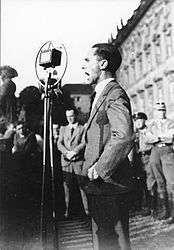
This was, however, a false comparison, as the "book burnings" at those historic events were not acts of censorship, nor destructive of other people's property, but purely symbolic protests, destroying only one individual document of each title, for a grand total of 12 individual documents, without any attempt to suppress their content, whereas the Student Union burned tens of thousands of volumes, all they could find from a list comprising around 4000 titles.[4]
The "Twelve Theses" called for a "pure" national language and culture. Placards publicized the theses, which attacked "Jewish intellectualism", asserted the need to "purify" German language and literature, and demanded that universities be centres of German nationalism. The students described the action as a “response to a worldwide Jewish smear campaign against Germany and an affirmation of traditional German values.”
On 6 May 1933, the German Student Union made an organised attack on Magnus Hirschfeld's Institute of Sex Research. Its library and archives of around 20,000 books and journals were publicly hauled out.
On 10 May 1933, the students burned upwards of 25,000 volumes of "un-German" books in the square at the State Opera, Berlin, thereby presaging an era of uncompromising state censorship. In many other university towns, nationalist students marched in torch lit parades against the "un-German" spirit. The scripted rituals of this night called for high Nazi officials, professors, rectors, and student leaders to address the participants and spectators. At the meeting places, students threw the pillaged, banned books into the bonfires with a great joyous ceremony that included live music, singing, "fire oaths," and incantations. In Berlin, some 40,000 people heard Joseph Goebbels deliver a fiery address: "No to decadence and moral corruption!" Goebbels enjoined the crowd. "Yes to decency and morality in family and state! I consign to the flames the writings of Heinrich Mann, Ernst Glaeser, Erich Kästner."
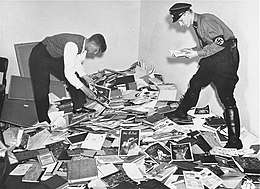
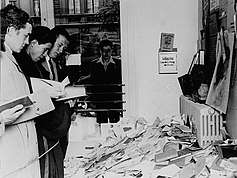
The era of extreme Jewish intellectualism is now at an end. The breakthrough of the German revolution has again cleared the way on the German path...The future German man will not just be a man of books, but a man of character. It is to this end that we want to educate you. As a young person, to already have the courage to face the pitiless glare, to overcome the fear of death, and to regain respect for death - this is the task of this young generation. And thus you do well in this midnight hour to commit to the flames the evil spirit of the past. This is a strong, great and symbolic deed - a deed which should document the following for the world to know - Here the intellectual foundation of the November Republic is sinking to the ground, but from this wreckage the phoenix of a new spirit will triumphantly rise.
— Joseph Goebbels, Speech to the students in Berlin
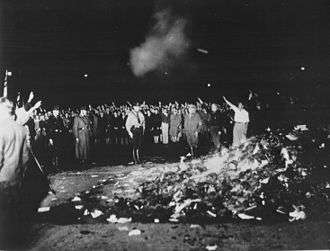

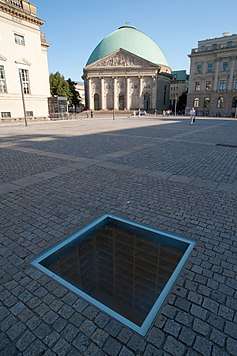
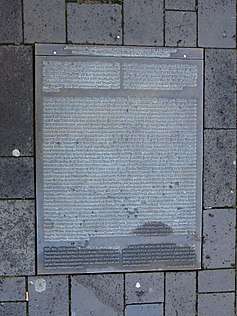
Not all book burnings took place on 10 May as the German Student Union had planned. Some were postponed a few days because of rain. Others, based on local chapter preference, took place on 21 June, the summer solstice, a traditional date of celebration. Nonetheless, in 34 university towns across Germany the "Action against the Un-German Spirit" was a success, enlisting widespread newspaper coverage. And in some places, notably Berlin, radio broadcasts brought the speeches, songs, and ceremonial incantations "live" to countless German listeners.
All of the following types of literature, as described by the Nazis, were to be banned:
- The works of traitors, emigrants and authors from foreign countries who believe they can attack and denigrate the new Germany (H. G. Wells, Romain Rolland);
- The literature of Marxism, Communism and Bolshevism;
- Pacifist literature;
- Literature with liberal, democratic tendencies and attitudes, and writings supporting the Weimar Republic (Walther Rathenau, Heinrich Mann, Thomas Mann);
- All historical writings whose purpose is to denigrate the origin, the spirit and the culture of the German Volk, or to dissolve the racial and structural order of the Volk, or that denies the force and importance of leading historical figures in favor of egalitarianism and the masses, and which seeks to drag them through the mud (Emil Ludwig);
- Books that advocate "art" which is decadent, bloodless, or purely constructivist (George Grosz, Otto Dix, Bauhaus, Felix Mendelssohn);
- Writings on sexuality and sexual education which serve the egocentric pleasure of the individual and thus, completely destroy the principles of race and Volk (Magnus Hirschfeld);
- The decadent, destructive and Volk-damaging writings of "Asphalt and Civilization" literati: (Oskar Maria Graf, Heinrich Mann, Stefan Zweig, Jakob Wassermann, Franz Blei);
- Literature by Jewish authors, regardless of the field;
- Popular entertainment literature that depicts life and life's goals in a superficial, unrealistic and sickly sweet manner, based on a bourgeois or upper class view of life;
- Patriotic kitsch in literature.
- Pornography and explicit literature by Jewish authors.
- All books degrading German purity.
Many German students were complicit in the Nazi book burning campaign. They were known as Deutsche Studentenschaft, and when they ran out of books in their own libraries they turned to independent bookstores. Libraries were also asked to stock their shelves with material that stood up to Hitler's standards, and destroy anything that did not.[5]
The Nazis also seized many books from Jewish communities in Eastern Europe. They did intend to keep and display a few rare and ancient books in a museum on Judaism after the Final Solution was successfully completed. [6]
Responses
The blind writer Helen Keller published an Open Letter to German Students: 'You may burn my books and the books of the best minds in Europe, but the ideas those books contain have passed through millions of channels and will go on.'"[7] On May 10, 1934, one year after the book burnings, the Germany Library of Burnt Books founded by Alfred Kantorowicz was opened to assemble copies of the books that had been destroyed. [8] Because of the shift in political power and the blatant control and censorship demonstrated by the Nazi party, 1933 saw a “mass exodus of German writers, artists, and intellectuals…”.[9] Some went to America, some to England, and some to France. On May 10, 1934, one year to the day after the mass book burning, those writers in exile in France came together and established the Library of the Burned Books where all the works that had been banned, burned, censored, and destroyed were collected.[8]
Alfred Kantorowicz, the author of the 1944 article Library of the Burned Books, was one of the key leaders instrumental in creating this library. In his article, he explains first-hand how the library came to be, and how it was finally destroyed. The library not only housed those books banned by the Nazis, the more important mission was to be the “center of intellectual anti-Nazi activities”.[8] In addition, it had extensive archives “on the history of Nazism and the anti-Nazi fight in all its forms”.[8] At the start of the war, the Nazis were virtually in control in France so the French government closed down the library and anyone associated was imprisoned or sent to concentration camps. Once the Nazis occupied Paris, the library and archives were turned over and that was the end of the Library.
In Kantorowicz’s words, “…the real significance of the Library was not confined to its material existence. When we inaugurated it, we wanted to make that day of shame a day of glory for literature and for freedom of thought which no tyrant could kill by fire. And furthermore, by this symbolic action, we wanted to awaken Europe to the dangers which threatened its spiritual as well as its material existence.”[8]
Persecuted authors
Among the German-speaking authors whose books student leaders burned that night were Vicki Baum, Walter Benjamin, Ernst Bloch, Franz Boas, Bertolt Brecht, Max Brod, Otto Dix, Alfred Döblin, Albert Einstein, Friedrich Engels, Lion Feuchtwanger, Marieluise Fleißer, Leonhard Frank, Sigmund Freud, Iwan Goll, George Grosz, Jaroslav Hašek, Werner Hegemann, Heinrich Heine, Hermann Hesse, Magnus Hirschfeld, Ödön von Horvath, Heinrich Eduard Jacob, Franz Kafka, Georg Kaiser, Erich Kästner, Alfred Kerr, Egon Kisch, Siegfried Kracauer, Karl Kraus, Theodor Lessing, Alexander Lernet-Holenia, Karl Liebknecht, Georg Lukács, Rosa Luxemburg, Heinrich Mann, Klaus Mann, Ludwig Marcuse, Karl Marx, Robert Musil, Carl von Ossietzky, Erwin Piscator, Alfred Polgar, Gertrud von Puttkamer, Erich Maria Remarque, Ludwig Renn, Joachim Ringelnatz, Joseph Roth, Nelly Sachs, Felix Salten, Anna Seghers, Arthur Schnitzler, Carl Sternheim, Bertha von Suttner, Ernst Toller, Kurt Tucholsky, Jakob Wassermann, Frank Wedekind, Franz Werfel, Grete Weiskopf, Arnold Zweig and Stefan Zweig.
Not only German-speaking authors were burned, but also French authors like Henri Barbusse, André Gide, Victor Hugo and Romain Rolland; American writers such as John Dos Passos, Theodore Dreiser, F. Scott Fitzgerald, Ernest Hemingway, Helen Keller, Jack London and Upton Sinclair; as well as English authors Joseph Conrad, Radclyffe Hall, Aldous Huxley, D. H. Lawrence and H. G. Wells; Irish writers James Joyce and Oscar Wilde; and Russian authors including Isaac Babel, Fyodor Dostoyevsky, Ilya Ehrenburg, Maxim Gorki, Vladimir Lenin, Vladimir Mayakovsky, Vladimir Nabokov, Leo Tolstoy, and Leon Trotsky.
The burning of the books represents a culmination of the persecution of those authors whose oral or written opinions were opposed to Nazi ideology. Many artists, writers and scientists were banned from working and publication. Their works could no longer be found in libraries or in the curricula of schools or universities. Some of them were driven to exile (such as Albert Einstein, Sigmund Freud, Magnus Hirschfeld, Walter Mehring, and Arnold Zweig); others were deprived of their citizenship (for example, Ernst Toller and Kurt Tucholsky) or forced into a self-imposed exile from society (e.g. Erich Kästner). For other writers the Nazi persecutions ended in death. Some of them died in concentration camps, due to the consequences of the conditions of imprisonment, or were executed (like Carl von Ossietzky, Erich Mühsam, Gertrud Kolmar, Jakob van Hoddis, Paul Kornfeld, Arno Nadel, Georg Hermann, Theodor Wolff, Adam Kuckhoff, Friedrich Reck-Malleczewen, and Rudolf Hilferding). Exiled authors despaired and committed suicide, for example: Walter Hasenclever, Ernst Weiss, Carl Einstein, Walter Benjamin, Ernst Toller, and Stefan Zweig.
Heinrich Heine wrote in his 1820-1821 play Almansor the famous admonition, "Dort, wo man Bücher verbrennt, verbrennt man am Ende auch Menschen": "Where they burn books, they will in the end also burn people."
Denazification
In 1946, the Allied occupation authorities drew up a list of over 30,000 titles, ranging from school books to poetry and including works by such authors as von Clausewitz. Millions of copies of these books were confiscated and destroyed. The representative of the Military Directorate admitted that the order in principle was no different from the Nazi book burnings.[10]
Artworks were under the same censorship as other media;
all collections of works of art related or dedicated to the perpetuation of German militarism or Nazism will be closed permanently and taken into custody.
The directives were very broadly interpreted, leading to the destruction of thousands of paintings and thousands more were shipped to deposits in the U.S. Those confiscated paintings still surviving in U.S. custody include, for example, a painting "depicting a couple of middle aged women talking in a sunlit street in a small town".[11]
Remembrance
Fighting the Fires of Hate: America and the Nazi Book Burnings is a traveling exhibition produced by the United States Holocaust Memorial Museum. Through historical photographs, documents, and films, it explores how the book burnings became a potent symbol in America's battle against Nazism and why they continue to resonate with the public—in film, literature, and political discourse—to this day.[12] In 2014, the exhibition was displayed in West Fargo, North Dakota; Dallas, Texas; and Missoula, Montana.[13]
When Books Went to War (Houghton Mifflin Harcourt), by Molly Guptill Manning, details the 1933 Berlin book burnings and tells the story of how America responded by printing hundreds of millions of books for Americans serving in World War II.
See also
- Wolfgang Herrmann, the librarian who created the original blacklist of books
- Books in Germany
- Degenerate art
- Denazification#Censorship
- List of authors banned in Nazi Germany
- List of book-burning incidents
- Destruction of Warsaw
References
Notes
- "Book Burning". United States Holocaust Memorial Museum.
- Strätz, Hans-Wolfgang (1968). Die studentische "Aktion wider den undeutschen Geist" im Frühjahr 1933. In: Vierteljahrshefte für Zeitgeschichte, 16 (in German). pp. 347–53.
- Bracher, Karl Dietrich (1970). The German Dictatorship. Translated by Jean Steinberg. New York: Penguin Books. p. 325. ISBN 0-14-013724-6.
- "When Books Burn: Lists of Banned Books, 1933-1939". www.library.arizona.edu.
- Battles, M (2003). "Knowledge On Fire". American Scholar. 3 (35).
- Lyons, Martyn. Books: A Living History. Los Angeles: J. Paul Getty Museum, 2011. chapter 5 p.200-1
- Baez 2011, p. 211
- Kantorowicz, A. (1944). Library of the Burned Books. The New Republic, 110(20), 686-688.
- Noble, L. (2019). "Burning Books". Cambridge University Library. Retrieved November 3, 2019.
- Read No Evil Time magazine, May 27, 1946
- Goldstein, Cora. "PURGES, EXCLUSIONS, AND LIMITS: ART POLICIES IN GERMANY 1933-1949". Archived from the original on December 23, 2007.
- "Fighting the Fires of Hate: America and the Nazi Book Burnings". United States Holocaust Memorial Museum.
- "Current Schedule: Fighting the Fires of Hate". United States Holocaust Memorial Museum. Retrieved August 13, 2014.
Bibliography
- Mauthner, Martin (2007) German Writers in French Exile, 1933-1940, London: Vallentine Mitchell. ISBN 978-0-85303-540-4
- This article incorporates text from the United States Holocaust Memorial Museum, and has been released under the GFDL.
External links
| Wikimedia Commons has media related to Book burning in Nazi Germany. |
- United States Holocaust Memorial Museum - Holocaust Encyclopedia: Book Burning
- United States Holocaust Memorial Museum - Library Bibliography: 1933 Book Burnings
- Jewish Virtual Library - The Burning of the Books
- "Fighting the Fires of Hate: America and the Nazi Book Burnings". Traveling exhibition produced by the United States Holocaust Memorial Museum.